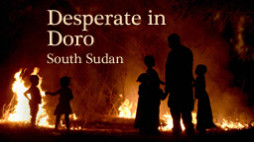
South Sudan continues to struggle for peace and autonomy after splitting from the North in 2011. With tribes displaced, they … Continue reading

South Sudan continues to struggle for peace and autonomy after splitting from the North in 2011. With tribes displaced, they … Continue reading
Though the borders separating North and South Sudan were established by the British in 1953, they weren't formally recognized until July 9, 2011, when South Sudan voted to secede from the predominantly Arab North. The resulting two countries left thousands of marginalized tribes living along a contentious border who, despite their proximity, sided more ethnically and politically with the South. In September, 2011, villages in the Upper Nile became the targets of North Sudan's Antonov bombers, as directed by Khartoum, who today continues to push these marginalized tribes south and--through terror--squelch a perceived threat to the North's primary interest-- oil. Displaced tribes, from Malakal to Yida and Bala Tuma, consist of Mayak, Uduk, and Jum Jum tribes who are Muslim, Christian, and Animists. The week before I arrived with doctor Alan Kelley a refugee camp in Yida and a market in Bala Tuma, 30 km away, were bombed resulting in 20 deaths and a mass migration south. Under the light of moon, thousands of traumatized villagers packed their belongings in wicker baskets and fled south to Doro. We arrived in Doro November 14, 2011. Within that week a small community of perhaps 1000 refugees grew to approximately 12,000. The surrounding forest and scrub become bare as refugees sought firewood, shelter and food. The UNHCR, who arrived just 24 hours before us, began registering 1000 refugees a day. They projected 40,000 refugees by December and up to 70,000 living in the surrounding bush by January, 2012.
This work is the result of two trips taken to the region in 1999. The first came just before NATO began their air attacks and the subsequent exodus of native Kosovars, many with Albanian roots, to neighboring Albania and Macedonia. The second trip was within days of the NATO and KFOR ground troop assault when Serbia ultimately withdrew from Kosova--a Yugoslavian province thirsting for independence. The following months revealed ghastly accounts from a traumatized rural population as Kosovars returned to torched homes and fields of massacred relatives. The Yugoslav war resulted in the largest human exodus in Europe since WWII. The majority of this work was shot on Tri-X and Fujichrome using Leica M6s and syndicated by Black Star Publishing. Prints are available for exhibition and educational purposes.